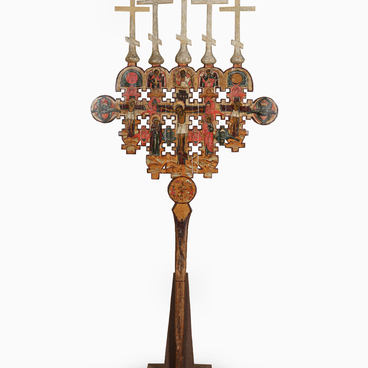The Ostrog Bible was the first complete edition of the Bible in the Church Slavonic language, prepared jointly by the Orthodox Prince Konstantin Ostrogski and a group of learned men who were part of the Ostrog School (Academy). A replica of the Bible is presented in the Museum of Russian Heritage.
The Ostrog Bible is a monument of East Slavic philological thought and 16th-century printing. It was published by the Ostrog Printing House by the first Russian printer Ivan Fyodorov in 1581 with the blessing of abbot Job of the Dubno Monastery.
The Bible is decorated in a restrained and simple manner. Figurative engravings are completely absent. The book was printed in two colors, but, unlike in the separate edition of the New Testament, cinnabar is used very little. It can only be seen on the first sheet and in the design of the menology — an ecclesiastical calendar of festivals celebrated in honor of particular saints and martyrs.
The work on the publication of the Bible took about five years. The printer faced many various obstacles, including difficulties with checking and editing versions, casting new fonts, and developing drawings. In particular, it was incredibly difficult to obtain an abundant supply of paper. One manufacturer of paper was unable to satisfy Ivan Fyodorov’s requests, so the printer had to establish extensive contacts with many other manufacturers. As a result, the Ostrog Bible is printed on paper with different filigree watermarks.
About seven types of watermarks can be found in the copy presented in the Museum of Russian Heritage. One of them, the “ax”, was used by the Tęczyński workshops located in Krzeszowice and in Tenczyn, near Krakow, and possibly in Lublin. In addition, the Bible features the coat of arms of Prince Ostrogski, on whose initiative this great task of printing was undertaken. One preface was written by the prince himself.
The total number of characters in the text is 3.24 million. The initial print run was approximately 1,500 copies. Shortly after its release, the Ostrog Bible was widely distributed throughout Eastern Slavic regions and eventually reached the southern Slavic communities.
About 350 Ostrog Bibles have been preserved to this day. They are kept in various countries. No other edition printed in Cyrillic script in the 16th century has survived in such numbers. Subsequently, the Ostrog Bible was reprinted in Moscow in 1663.



